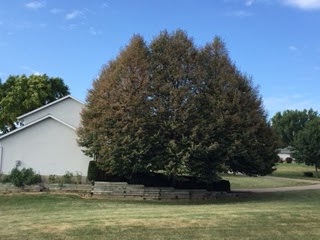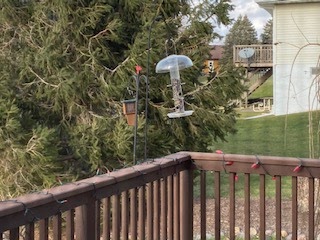Experts weigh in on JBs, or Japanese Beetles
These three Linden trees are packed full of Japanese beetles; they are the favorite "food" of the beetles.
The bad news: There is very little a local gardener can safely do about controlling Japanese Beetles, called "JBs" by three experts I consulted.
The good news: The beetles have basically exited a yard in Ames, Iowa, and might be gone from Scott County, Iowa, as early as Aug. 15-16.
Experts consulted were the state's entomologist, Dr. Donald Lewis, of Iowa State University, Ames, and his colleague, Dr. Mark Shour, also an entomology professor and with the university's Pesticide and Education Safety Program, part of ISU Extension & Outreach. Richard Jauron, a noted horticulturist and ISU professor of horticulture, also weighed in.
According to Lewis, contacted while he was traveling, the JBs were spotty in his yard in Ames, and have already disappeared. Typically the JB season starts in late June in Iowa and ends in mid-August, he added, although some years they will be present into September.
The warm June we had this year jump-started the beetle's emergence, Shour said in an e-mail message. A population of JBs emerging as adults (the stage where the insects attack trees and plants) can spread over several weeks, and is affected by several factors, including the ferocity of winter weather. If the winter is harsh enough, the frost line extends into the ground and kills the grubs, which evolve into adult JBs.
Shour quotes Water Fleming, a national researcher which the U.S. Department of Agriculture. While the generally accepted lifespan of the beetle is 30-45 days, Fleming led laboratory tests that showed males could live as long at 74 days, and females 105 days. Let's hope that's not the case this year!
Other factors impacting the JB lifespan, Shour said, are temperature extremes, quality of the "host food" the beetles find after they emerge, and predators in the area. Birds found to eat the beetles are starlings, robins, crows, grackles, blue jays, and others.
About temperate extremes, Shour said the adult JBs function well in temperatures from 55-95 degrees Farenheit.
Shour believes the beetles in Iowa may be present into September. "I wise I had better news," he said.
Jauron, who is a regular guest on Iowa Public Radio and speaks on gardening topics of all kinds, said there is nothing an individual can do to reduce the population of JBs from one year to the next. Treating the lawns this season, for example, will not reduce the population the following year.
There you have it. What will be, will be.
The bad news: There is very little a local gardener can safely do about controlling Japanese Beetles, called "JBs" by three experts I consulted.
The good news: The beetles have basically exited a yard in Ames, Iowa, and might be gone from Scott County, Iowa, as early as Aug. 15-16.
Experts consulted were the state's entomologist, Dr. Donald Lewis, of Iowa State University, Ames, and his colleague, Dr. Mark Shour, also an entomology professor and with the university's Pesticide and Education Safety Program, part of ISU Extension & Outreach. Richard Jauron, a noted horticulturist and ISU professor of horticulture, also weighed in.
According to Lewis, contacted while he was traveling, the JBs were spotty in his yard in Ames, and have already disappeared. Typically the JB season starts in late June in Iowa and ends in mid-August, he added, although some years they will be present into September.
The warm June we had this year jump-started the beetle's emergence, Shour said in an e-mail message. A population of JBs emerging as adults (the stage where the insects attack trees and plants) can spread over several weeks, and is affected by several factors, including the ferocity of winter weather. If the winter is harsh enough, the frost line extends into the ground and kills the grubs, which evolve into adult JBs.
Shour quotes Water Fleming, a national researcher which the U.S. Department of Agriculture. While the generally accepted lifespan of the beetle is 30-45 days, Fleming led laboratory tests that showed males could live as long at 74 days, and females 105 days. Let's hope that's not the case this year!
Other factors impacting the JB lifespan, Shour said, are temperature extremes, quality of the "host food" the beetles find after they emerge, and predators in the area. Birds found to eat the beetles are starlings, robins, crows, grackles, blue jays, and others.
About temperate extremes, Shour said the adult JBs function well in temperatures from 55-95 degrees Farenheit.
Shour believes the beetles in Iowa may be present into September. "I wise I had better news," he said.
Jauron, who is a regular guest on Iowa Public Radio and speaks on gardening topics of all kinds, said there is nothing an individual can do to reduce the population of JBs from one year to the next. Treating the lawns this season, for example, will not reduce the population the following year.
There you have it. What will be, will be.




Comments
Post a Comment